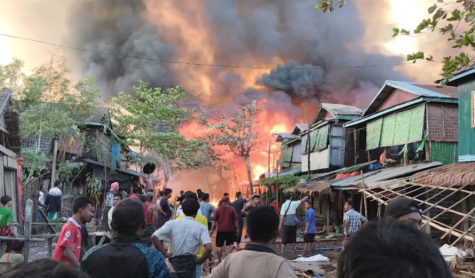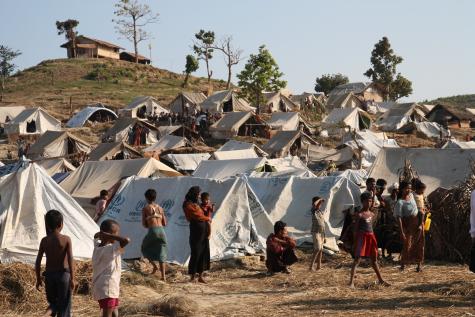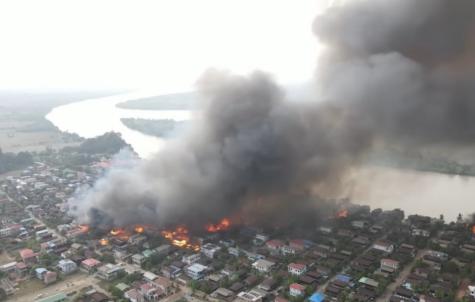MYANMAR

➡️ MYANMAR CIVIL WAR (2021 – Ongoing)
One of the Longest Running Civil Conflicts, Ignored by the West, Fuelled by the East
The civil war in Myanmar is currently one of the worst conflicts in the world. Sparked by a military coup four years ago, brutal fighting between the military junta and more than 2,600 rebel groups has led to the death of more than 6,000 civilians and displaced 3.5 million people.
Since the coup ousted the democratically elected government led by Aung San Suu Kyi, citing election fraud, the country has descended into chaos. These claims by the state army, also known as the Tatmadaw, have been rejected by international observers.
Millions of demonstrators took to the streets to protest and were met with violence from security forces who shot and arrested civilians, activists and journalists. What started as large-scale peaceful protests quickly escalated into armed resistance, and Myanmar descended into civil war. The country is currently ruled under a brutal military dictatorship.
Jump straight to our resources on the ➡️ Myanmar Civil War
Explore our comprehensive guides on -
-
Military Coup in 2021 and the Resulting Civil War
-
Political Situation in Myanmar
-
Human Rights Crisis in Myanmar
-
Justice for Myanmar – Exposing those who profit from & fund war crimes
1948 Myanmar Independence & 77 Years of Armed Conflict
The roots of conflict in Myanmar stem from the country's colonial past and its subsequent political development after independence. The country, officially called Burma until 1989, was under British colonial rule from 1824 to 1948. During this time, the British settled various ethnic groups and ruled according to the principle of "divide and rule." This policy exacerbated tensions between the majority ethnic Burmese and the many different minority groups, such as the Karen, Kachin, Shan, Rohingya, and Chin.
After independence in 1948, a civilian government assumed power, but internal conflicts soon shook the country. Many of the ethnic groups demanded greater autonomy or independence, as their expectations of political participation fell short. Armed movements emerged, including the Karen National Union (KNU), the Kachin Independence Army (KIA), the Arakan Army (AA), and the Ta'ang National Liberation Army (TNLA).
The situation reached a new low in the 1960s after General Ne Win staged a coup, overthrowing the democratically elected government and establishing an authoritarian military regime. The military centralised power, oppressed ethnic minority groups, and implemented a socialist planned economy that ultimately failed.

For decades, the military waged a gruelling war against numerous ethnic rebel groups that had established their own enclaves in the border regions. Although there were some ceasefires in the 1990s, no lasting political solution was found. In 2011, the military initiated a shift to democratisation, which resulted in a semi-civilian government under President Thein Sein. Then in 2015, pro-democracy icon Aung San Suu Kyi and the National League for Democracy (NLD) took the reins.
Despite the appearance of democratic elections and institutions, the constitution ensured that the military retained crucial positions of power, such as control of security ministries and a mandatory 25% of the parliamentary seats. The fragile reform process collapsed in 2021 when the military, under General Min Aung Hlaing, seized full power in a coup which ousted the civilian government.
Who is Fighting Who?
The many groups fighting against the military in Myanmar range from democratic-liberal to left-progressive, and also ethno-nationalist motivated movements. Part of the resistance, especially the People's Defence Forces (PDF), which emerged after the 2021 military coup, consists mainly of young people, students, and activists who were previously involved in the pro-democracy movement.
These young activists are fighting for democratic transformation and demand a federal, pluralistic system that includes ethnic minorities on an equal footing. They also advocate for greater respect for human rights, decentralisation of governance, citizen empowerment, and social reforms addressing issues such as poverty, discrimination, and workers' rights.
Many ethnic rebel groups were active long before the coup and pursue their own political goals, such as regional autonomy or independence. They are less driven by ideology and more motivated by power politics. Some of these groups have established their own political institutions, enabling democratic structures in certain regions, while others are led in a more authoritarian manner.
Despite their different goals and diverse range, a degree of cooperation has developed among the groups since 2021. Many are now working alongside the exiled "National Unity Government" (NUG), a democratic counter-government comprising elected lawmakers and members of parliament ousted in the coup.
The NUG is attempting to design a federal and inclusive system that factors in the demands of ethnic minorities and the pro-democracy movement. It has broad support among students, civil society organisations, and segments of the population who are frustrated with decades of military rule. Young people, in particular, support the NUG, as many of them fundamentally reject the old, centralist, authoritarian model and are desperate for change.

Human Rights Crisis in Myanmar
Since the military coup in early 2021, the human rights situation in Myanmar has developed into a deeply concerning crisis. War crimes, including the arbitrary killing of civilians, air and artillery attacks on populated areas, the destruction of villages and civilian infrastructure, the use of landmines, and evidence of torture and sexual violence, have all been recorded by rights groups.
Forced recruitment is widespread, and according to the Human Rights Watch, over 1,800 children were forcibly conscripted by the military or allied forces in 2024 alone. Villagers in conflict zones are frequently coerced into service under threat of their lives.
From the end of 2024, the junta controlled less than half of the country's territory. Current sources suggest that the figure is now only 20-30%. In some states, such as Kayah State, ethnic resistance groups already control approximately 80% of the territory. The fiercest fighting in 2024 raged in the states of Chin, Kachin, Kayah, Shan, and Rakhine, where the resistance had seized control of large areas. The army responded with relentless, systematic and indiscriminatory airstrikes and artillery shelling of towns and villages.
According to an analysis by Action on Armed Violence (AOAV), over 450 air and explosive attacks were documented in 2024 alone, killing or injuring 3,800 people – 89% of them civilians. Entire villages are repeatedly burned to the ground, schools and hospitals destroyed, and food depots bombed. In October 2025, The Guardian reported an army attack on a protest rally using a motorised glider, killing at least 20 people, including several children.
According to the United Nations, around 3.5 million people are currently internally displaced within Myanmar, with another million in neighbouring countries such as Thailand, India, and Bangladesh. Approximately 20 million people, almost a third of the population, require humanitarian assistance. Entire regions are suffering from food shortages due to the destruction of crops and disruptions to supply routes.
Famine is looming, particularly in Rakhine State in the west of the country. A recent Reuters report from October 2025 describes a dramatically worsening food crisis, with 16 million people already lacking regular access to food. Diseases such as malaria, dengue fever, and diarrhoea are also spreading due to destroyed infrastructure and a lack of medical care.

International Support for the Junta
Internationally, the war has been widely condemned, but serious reactions have been largely absent. The United Nations regularly warns of a "humanitarian catastrophe of historic proportions," yet diplomatic efforts have been ineffective. The U.S., EU, UK, Canada, and other countries have imposed sanctions on leading military figures, regime-affiliated companies, and state-owned energy corporations. But many of these measures have had little impact, as the military junta continues to receive substantial support from several influential states.
Russia is one of the regime's most important allies. Since the 2021 coup, Moscow has supplied arms worth over $400 million, including MiG-29 and Su-30 fighter jets, helicopters, and rocket artillery. China also plays a key role and, according to UN reports, has supplied Myanmar with weapons worth around $270 million, including light armoured vehicles, drones, and ammunition. India, through state-owned and private companies such as Yantra India and Bharat Electronics Limited, has supplied artillery components, radar systems, and communications equipment for military use.
In addition to military support, the junta benefits from far-reaching economic ties. Singapore, in particular, serves as an important financial and investment hub. Singaporean companies, such as Interra Resources, remain active in oil and gas production, supplying the military-controlled state-owned company MOGE with millions of barrels of crude oil. Chinese state-owned enterprises, such as the Aviation Industry Corporation of China (AVIC), also provide aircraft and technology. Meanwhile, some international corporations, including Airbus, which held shares in AVIC until 2024, severed their ties only after facing public pressure.
The UN Office for the Coordination of Humanitarian Affairs (OCHA) recently criticised the fact that only 4% of the desperately required international aid funds have actually been delivered. UN observers are already warning that Myanmar is heading towards complete state collapse.
Failed Peace Efforts from Asia
A key player in the peace negotiations has been the Association of Southeast Asian Nations (ASEAN), which adopted a Five-Point Consensus after the 2021 military coup. This consensus calls for a ceasefire, humanitarian access, dialogue among all parties, and the deployment of an ASEAN special envoy. However, the military leadership refuses to fully implement the plan, completely stalling progress.
Another active mediator is neighbouring China, which has focused its efforts on northern Myanmar. In early 2025, they brokered an agreement between the military government and the ethnic rebel group Myanmar National Democratic Alliance Army (MNDAA) near the Chinese border, which officially designated an immediate ceasefire.

For China, the agreement was less about altruistic peace efforts and more about safeguarding its own regional interests. They seek stability along its southern border to protect cross-border trade, infrastructure projects, and Chinese citizens. They also want to preserve Chinese companies' access to raw materials, energy projects, and trade routes, for example, within the framework of the Belt and Road Initiative (BRI). China could play a key role in the peace process, but instead, they are more concerned with economic interests.
Thailand has also offered to mediate and has established border patrols as humanitarian corridors. An offer of direct mediation has been made. However, it remains unclear whether these attempts will lead to genuine dialogue. Thailand also collaborates with the junta. The country obtains a significant portion of its natural gas from Myanmar, which is exported to Thailand via pipelines. The Thai energy company PTT (Petroleum Authority of Thailand) continues to collaborate with the junta and the Myanmar state-owned company MOGE (Myanmar Oil and Gas Enterprise). Drawing international criticism, the revenues from these deals flow directly into the pockets of the military government.
Minimal Interest from the West
The U.S. government under Donald Trump formally maintains existing sanctions against leading military figures, state-owned enterprises, and banks, but displays a less committed stance than the previous administration. While humanitarian aid for the population continues, Washington has reduced its diplomatic pressure, lifted some sanctions, and shifted its focus more towards geopolitical competition with China. UN experts accuse the Trump administration of indirectly giving the junta more room to manoeuvre.
The European Union has extended its restrictive measures until April 2026, including travel bans, asset freezes, and a comprehensive arms embargo. At the same time, the EU is providing targeted support to civil society organisations, ethnic communities, and refugee assistance programs in the border regions to mitigate the humanitarian consequences of the civil war and strengthen democratic structures in the long term.
Despite the EU sanctions, many of the military junta's most significant sources of income, such as natural gas and raw material exports, remain largely unaffected, as numerous transactions are conducted through states or companies that are not sanctioned or are only partially sanctioned. At the same time, the junta can still access militarily relevant technologies, such as European components for drone systems, through third countries and partner companies.
Myanmar is currently on the verge of collapse. The military clings to power with brutal force, while the population lives in poverty, fear, and insecurity. The resistance is determined to overthrow the regime, but it remains questionable whether the various groups can cooperate peacefully in the long term. International observers are increasingly comparing the situation to Syria, a devastated country, with millions displaced, a weak international community, and an endless war.
Without decisive international mediation, massive humanitarian aid, and pressure on the regime, Myanmar risks becoming another forgotten war, with devastating consequences for the entire Southeast Asian region.
Author: Maximilian Stark 21.10.25, translated and edited by Rachael Mellor 14.11.25 licensed under CC BY-SA 4.0
For further reading on the Myanmar Civil War see below ⬇️